HVLS fans are large industrial fans for vast spaces, while regular fans are smaller and designed for residential or small commercial areas.
Design and Structure
When discussing the intricacies of fan design, it’s essential to comprehend the distinctions between HVLS (High Volume, Low Speed) fans and conventional regular fans. These differences play pivotal roles in dictating performance, energy efficiency, and application purposes. Let’s delve into the design specifics of both.
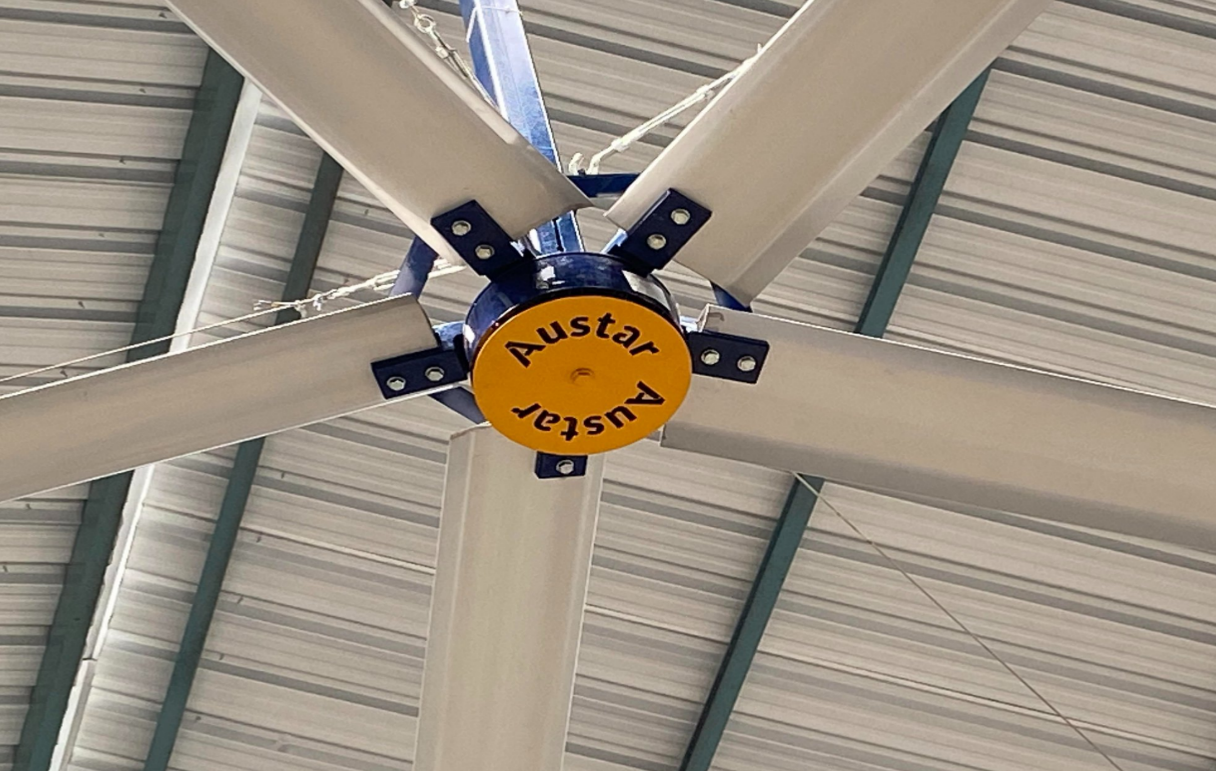
Blade Design of HVLS Fans
Typically, these blades can span from 8 feet to 24 feet in diameter. Due to this expansive blade size, HVLS fans can move a considerable volume of air even at low rotational speeds. The blade design often incorporates an aerofoil shape, ensuring maximum air movement with minimal drag. This design plays a critical role in achieving its namesake feature – high volume air movement at lower speeds. Moreover, the slight tilt or pitch in the blades aids in pushing a column of air down and out, which ensures effective de-stratification and ventilation in large spaces. The aerofoil design also contributes to the fan’s energy efficiency, as it requires less power to move large volumes of air.
Blade Design of Regular Fans
Conventional fans, often found in homes and offices, have a compact blade design. The blades of regular fans usually span anywhere from 12 inches to 56 inches. Unlike the aerofoil shape seen in HVLS fans, these blades tend to be flat or have a slight curve. While they rotate at higher speeds compared to HVLS fans, they circulate a smaller volume of air. The intent behind their design is to provide immediate relief in smaller areas, ensuring effective air movement in localized spaces. It’s worth noting that while the blade design is efficient for smaller spaces, it may not be as energy-efficient as HVLS fans when considering the volume of air moved per unit of power consumed.
Motor Differences
At the heart of both HVLS fans and regular fans lies the motor – the powerhouse that drives the blades. HVLS fans generally use gearless, direct-drive motors. These motors, due to the absence of gears, have fewer moving parts, which translates to reduced maintenance needs and longer lifespan. Moreover, they are more energy-efficient and generate less heat, making them ideal for continuous operation in commercial setups.
On the other hand, regular fans primarily utilize single-phase induction motors. These motors are perfect for their intended use, offering reliable performance for daily household or office use. However, they tend to have a shorter lifespan than the motors used in HVLS fans, especially when subjected to continuous operation.
For more in-depth insights on fan designs and structures, one might consider browsing the Wikipedia page on fans.
Performance and Efficiency
In the realm of fans, performance and efficiency largely depend on airflow, circulation, and energy consumption. Here, we’ll analyze the performance and efficiency of both HVLS and regular fans, shedding light on their capabilities and shortcomings.
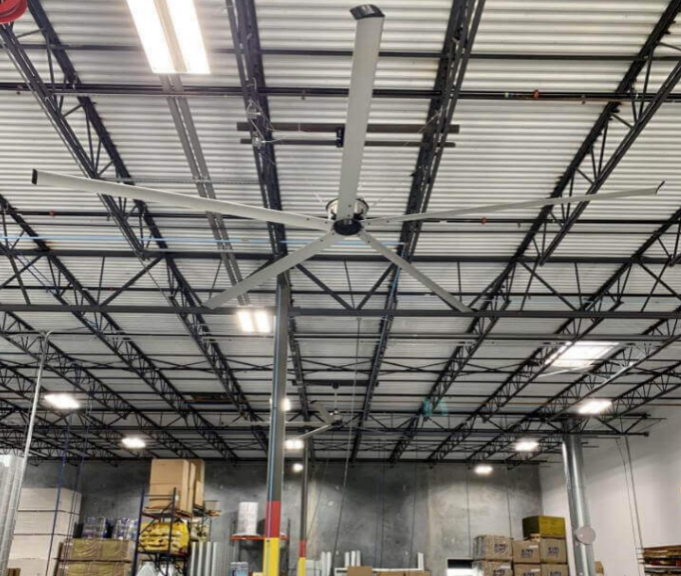
Airflow and Circulation in HVLS Fans
HVLS fans excel in circulating large volumes of air over vast spaces. Due to their expansive blade design, even at low speeds, they can generate an airflow that spans a large area. This is particularly useful in environments like warehouses, gyms, and hangars where the goal is to maintain consistent airflow across the entire area. A significant benefit of HVLS fans is their ability to prevent air stratification. By circulating air effectively, they ensure that there’s an even temperature throughout the space, reducing the need for additional heating or cooling. This characteristic not only ensures comfort but also can result in energy savings, as the HVAC systems don’t need to work as hard.
Airflow and Circulation in Regular Fans
Regular fans operate on a different scale. Designed primarily for localized cooling, their compact blade structure ensures that they can deliver focused airflow, making them ideal for rooms, offices, and small areas. The faster rotational speed of regular fans helps in generating a cooling effect quickly, offering immediate relief. However, they don’t have the capability to prevent air stratification over larger spaces or deliver even airflow in expansive environments. As such, their efficiency shines in smaller settings where rapid airflow is more crucial than even distribution.
Energy Consumption Comparison
HVLS fans, given their design and motor structure, often consume less energy per unit volume of air circulated compared to regular fans. For instance, a typical HVLS fan may use between 0.5 to 1.5 kW of power to move air in a space that spans thousands of square feet, ensuring energy efficiency on a larger scale. In contrast, a regular fan might consume around 50 to 75 watts of power but covers a much smaller area. On a per-unit-area basis, HVLS fans tend to be more energy-efficient, especially when considering the volume of air they move and the spaces they cover. For those interested in diving deeper into the world of energy consumption, the Wikipedia page on Energy Conservation offers valuable insights.
In conclusion, while both HVLS and regular fans serve their unique purposes and environments, it’s evident that HVLS fans stand out in terms of performance and efficiency in larger spaces. Regular fans, on the other hand, provide quick and localized cooling in more confined settings.
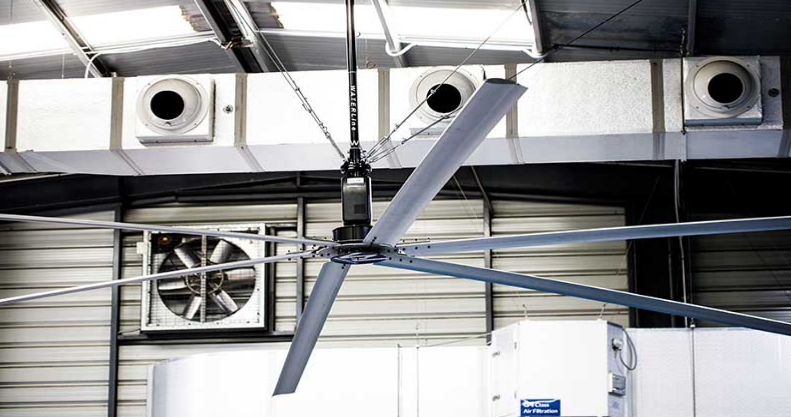
Application Areas
Both types of fans have specific environments where they perform at their best, catering to the unique requirements of that setting. By understanding these application areas, individuals and businesses can make informed decisions tailored to their specific needs.
Common Uses of HVLS Fans
HVLS fans, with their vast wingspan and capacity to circulate large volumes of air, find their best use in expansive areas. Some of the notable uses include:
- Warehouses and Distribution Centers: In these expansive spaces, maintaining consistent air circulation and temperature can be a challenge. HVLS fans tackle this by preventing air stratification and ensuring even distribution of air. This not only improves working conditions but can also protect stored goods, especially those sensitive to temperature variations.
- Airports and Hangars: These vast open structures benefit immensely from HVLS fans. They help in ensuring that large waiting areas or hangar spaces have consistent airflow, enhancing comfort and safety.
- Manufacturing Plants: In environments where machinery is constantly running, maintaining air quality and temperature can be crucial. HVLS fans aid in dispersing heat and ensuring that workers have a comfortable environment.
- Agricultural Settings: In places like barns or greenhouses where livestock or plants might be sensitive to temperature variations, HVLS fans ensure consistent conditions.
- Gyms and Recreational Facilities: These areas, often frequented by people engaging in physical activity, require consistent airflow to ensure comfort. HVLS fans rise to the occasion by providing even air circulation.
For those keen on understanding the mechanics behind large space ventilation and cooling, the Wikipedia page on HVAC provides a comprehensive overview.
Common Uses of Regular Fans
Regular fans, designed for more localized and immediate airflow, shine in compact settings. Their primary application areas include:
- Residential Spaces: In homes, whether it’s living rooms, bedrooms, or kitchens, regular fans offer immediate relief, especially during warmer days.
- Offices: For personal comfort in workspaces, regular fans can be invaluable. They provide localized cooling, ensuring employees remain comfortable.
- Shops and Small Commercial Areas: In settings like small retail shops or restaurants, regular fans can ensure that customers have a pleasant experience.
- Outdoor Events: For events like garden parties or small gatherings, regular fans can be strategically placed to provide guests with cooling.
- Personal Use: Many people utilize regular fans on desks or bedside tables for focused airflow while working or resting.
For an in-depth understanding of the history and types of fans tailored for smaller spaces, one can explore the Wikipedia page dedicated to fans.
In essence, the choice between HVLS and regular fans boils down to the scale of the application. While HVLS fans dominate in expansive settings, regular fans cater perfectly to intimate and localized environments.
Safety and Maintenance
Both HVLS and regular fans have been designed with user safety in mind. Additionally, their maintenance requirements can differ due to their size, structure, and areas of application. When choosing a fan, considering these aspects can be just as vital as evaluating performance and efficiency.
Safety Features of HVLS Fans
HVLS fans, given their large size and application areas, come equipped with specific safety features:
- Safety Guards and Cages: These prevent any accidental contact with the blades, especially essential in commercial or public areas.
- Overload Sensors: In case of an obstruction or malfunction, these sensors can automatically shut off the fan to prevent any damage or injury.
- Stable Mounting Systems: To handle the weight and size of HVLS fans, manufacturers design robust mounting systems that ensure the fan remains stable even during continuous operation.
Safety Features of Regular Fans
Regular fans, common in household settings, also come with their set of safety features:
- Protective Grills: These grills prevent fingers or objects from coming into contact with the moving blades.
- Tip-over Switch: Some fans are designed to automatically turn off if they are tipped over, reducing potential hazards.
- Thermal Overload Protectors: These protect the motor from overheating, ensuring a longer lifespan and reduced fire risk.
Maintenance and Lifespan Comparison
| Aspect | HVLS Fans | Regular Fans |
|---|---|---|
| Maintenance Frequency | Less frequent due to fewer moving parts and robust design. | More frequent, especially if used daily. Dust accumulation can be a common issue requiring regular cleaning. |
| Lifespan | Longer, often exceeding 15-20 years with proper maintenance due to industrial-grade components. | Shorter in comparison, usually between 5-10 years depending on usage and maintenance. |
| Common Maintenance Issues | Motor lubrication, checking mounting stability, and cleaning large blades. | Cleaning blade dust, checking and sometimes replacing motor bearings, and ensuring protective grills are intact. |
| Cost Implications | Generally higher initial investment, but less frequent maintenance can lead to cost savings over time. | Lower upfront cost, but potential for more regular maintenance or replacements. |
For those keen on exploring more about mechanical maintenance and safety, the Wikipedia page on Safety Engineering can be a valuable resource.
In summary, while both HVLS and regular fans prioritize safety, their maintenance needs can differ. HVLS fans, built for industrial and commercial settings, often offer longevity and require less frequent check-ups.
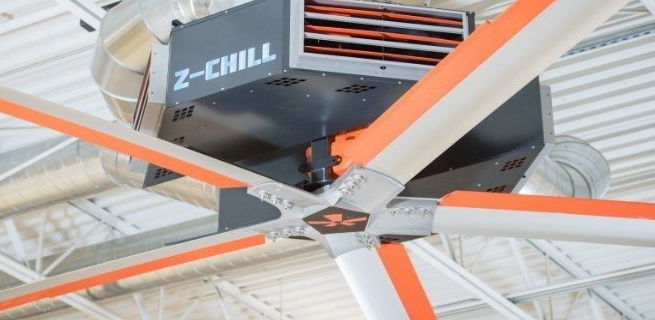
Cost Implications
When deciding between HVLS fans and regular fans, understanding the cost implications is crucial.
Initial Investment for HVLS Fans
Depending on the brand, model, size, and specific features, the cost of an HVLS fan can range between $2,000 to $8,000 or even more. For an in-depth understanding of industrial equipment pricing, this Wikipedia page on Industrial Equipment might be of interest.
Initial Investment for Regular Fans
Regular fans, tailored for residential or small commercial spaces, are much more affordable upfront. Prices can range from as low as $20 for a basic desk fan to upwards of $500 for high-end, feature-rich models like bladeless fans or those with advanced air purification systems. The installation or setup for these fans is typically straightforward and often doesn’t incur additional costs. For more insights into consumer electronics pricing trends, the Wikipedia page on Consumer Electronics provides valuable information.
Long-term Financial Benefits
The real cost benefits of any appliance, including fans, become apparent when we look at long-term implications:
- Energy Efficiency: HVLS fans, due to their design, often consume less energy per unit volume of air circulated compared to regular fans. While a regular fan might be more energy-efficient for a small room, an HVLS fan can efficiently cover vast spaces like warehouses, leading to substantial energy savings in the long run.
- Maintenance Costs: As discussed earlier, HVLS fans often have longer maintenance intervals, resulting in potential cost savings over time. On the other hand, regular fans, especially those in constant use, might need more frequent maintenance or even replacements.
- Longevity and Replacement Costs: An HVLS fan, with proper maintenance, can easily last over 15 years. This longevity means businesses or homeowners won’t need to reinvest in new fans frequently. In contrast, regular fans might need replacement every 5-10 years depending on usage, leading to cumulative costs.
- Additional Benefits: The efficiency of HVLS fans in maintaining consistent temperatures can lead to savings in other areas, like reduced HVAC usage or fewer needs for auxiliary cooling methods.
In conclusion, while HVLS fans have a higher initial investment, their long-term financial benefits, especially in larger settings, can make them a cost-effective choice. Regular fans, with their lower upfront cost, are perfect for immediate, localized cooling needs without significant financial commitments. However, considering their lifespan and potential for more frequent maintenance, the long-term costs can accumulate.
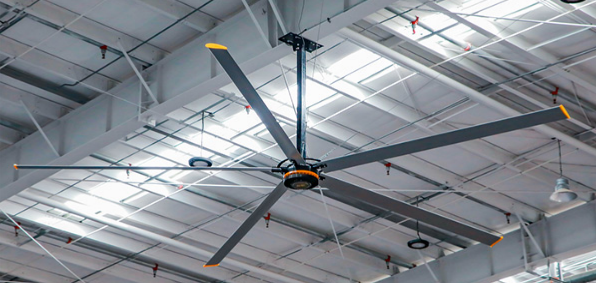
Environmental Impact
In an era where environmental considerations play a pivotal role in our purchasing decisions, understanding the environmental impact of products is essential. Both HVLS and regular fans come with their carbon footprints, which essentially represents the amount of carbon dioxide emissions for which they are directly or indirectly responsible. By understanding these footprints, consumers and businesses can make more environmentally-friendly choices.
Carbon Footprint of HVLS Fans
HVLS fans, given their scale and operational areas, have certain environmental implications:
- Manufacturing Impact: The production of HVLS fans, considering their size and the materials used (typically industrial-grade metals), can have a significant carbon footprint. The extraction, processing, and transportation of these materials all contribute to emissions.
- Operational Impact: HVLS fans, due to their efficient design, often consume less electricity per cubic foot of air circulated compared to several regular fans operating in the same space. With electricity generation being a primary contributor to greenhouse gas emissions, especially in regions reliant on fossil fuels, the efficient operation of HVLS fans can lead to a reduced carbon footprint over their lifetime.
- Longevity and Waste: HVLS fans are designed to last, often exceeding 15-20 years with proper maintenance.
For a broader perspective on industrial product impacts, the Wikipedia page on Environmental Impact Assessment provides a detailed overview.
Carbon Footprint of Regular Fans
Regular fans, predominantly used in residential settings, have their environmental considerations:
- Manufacturing Impact: While smaller in size, the sheer volume of regular fans produced can contribute significantly to emissions. The materials, though less than HVLS fans, coupled with mass production processes, contribute to their carbon footprint.
- Operational Impact: On a per unit basis, a regular fan consumes less power than an HVLS fan.
- Lifespan and Waste: Regular fans tend to have a shorter lifespan, often between 5-10 years. This means more frequent replacements, leading to increased waste and manufacturing impacts.
In conclusion, both HVLS and regular fans come with their environmental considerations. While HVLS fans might have a higher initial manufacturing impact, their efficient operation and longevity can result in a reduced long-term footprint. Regular fans, though smaller, can accumulate environmental impacts due to their shorter lifespan and potential need for multiple units in larger spaces. Making informed choices based on these impacts can guide us towards a more sustainable future.
